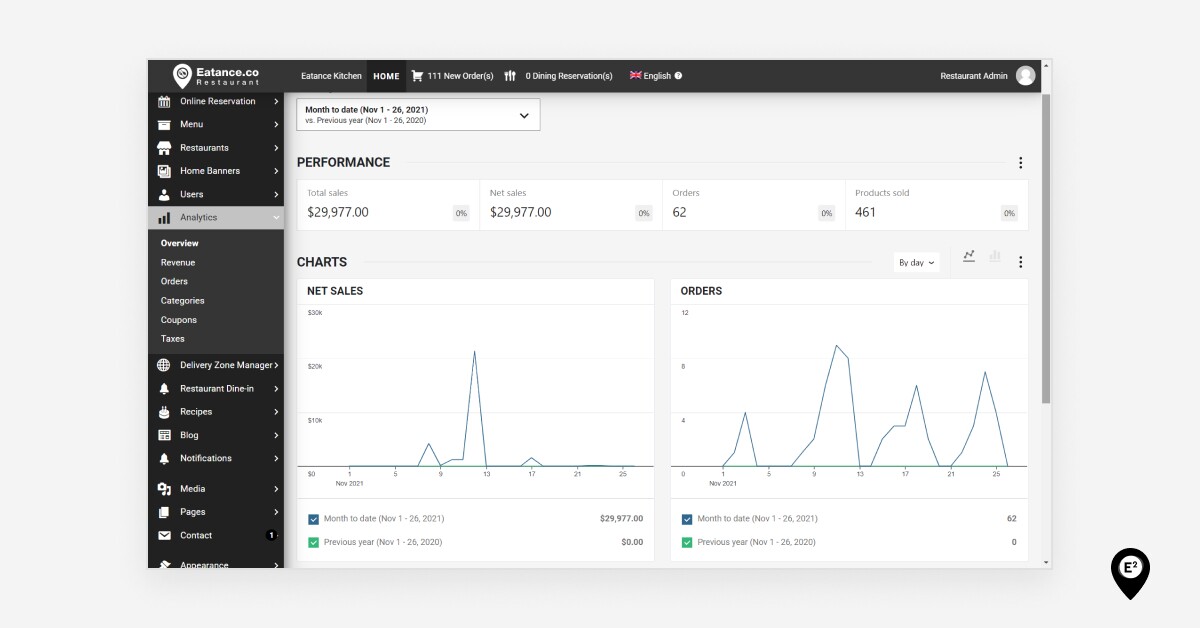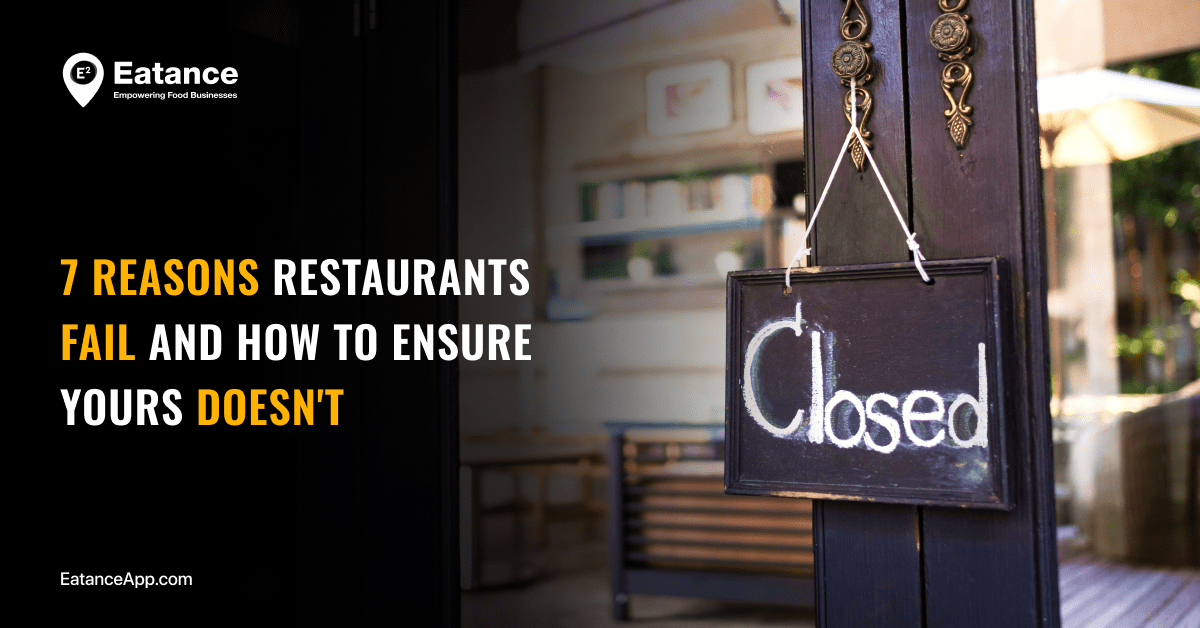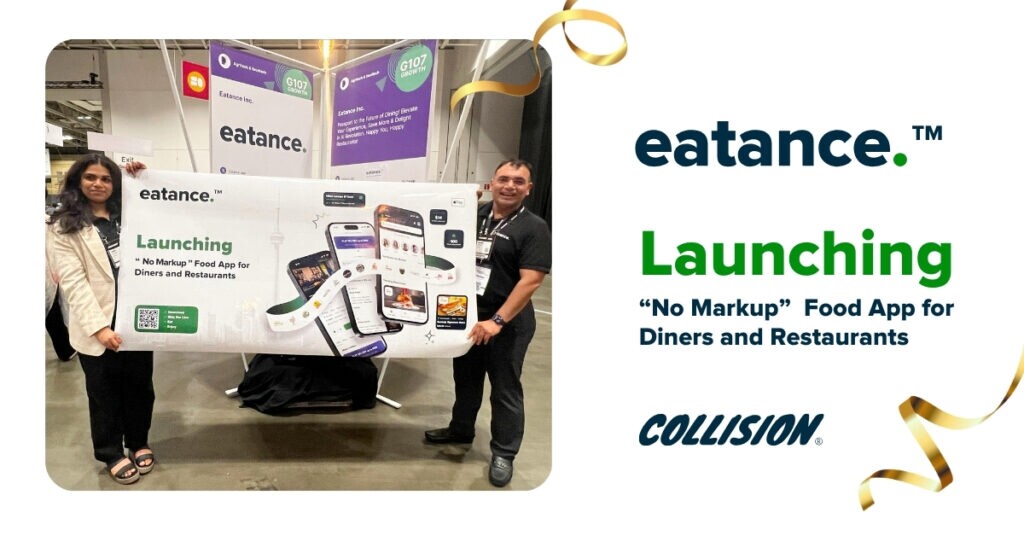Running a restaurant is a tough business. 60% of restaurants fail within the first year. Moreover, 80% of restaurants shut their business before their fifth anniversary.
We don’t mean to discourage aspiring (and current) restaurateurs. But, we believe taking preventive measures beforehand is always a better idea.
By learning the common pitfalls, you can make the right decisions to prevent your restaurant from failing.
Why Do Most Restaurants fail?
While there are several reasons why restaurants fail, here are the top ones:
1. Bad Location
The location of your restaurant plays a crucial role in its success. To increase the chances of success, you will need an easy-to-find location, ample parking space, and the area must be populated enough to generate footfall.
However, good locations come with a premium price, and most restaurants are unable to cover the costs (especially in the first few months).
How to Avoid This Problem?
One way to avoid this problem is by finding a location with low rent. This could take time, but it will minimize the risk of failure in the long run. Also, make sure your location is close to your target audience.
For instance, if your primary target audience is university students, open your restaurant in an area where they hang out. Then, visit the market a couple of times to understand the spending habits of people frequenting the area. This will help narrow down your choices.
Another great way to avoid this problem is by offering online ordering services. Even with a great location, online ordering can bring customers who cannot visit your restaurant frequently or stay far from you. This will help you expand your customer base quickly.
But remember, to manage online ordering, you will need a Restaurant Website Design. With Eatance, you will get your own restaurant website and restaurant mobile app that your customers can use to place food orders. Eatance also allows you to create a customizable digital menu for online ordering, accept orders, manage delivery charges, and analyze your restaurant’s performance.
2. Poor Customer Experience
While you need new customers to generate continuous sales, retaining the existing ones is equally important. Old customers will return more often to your restaurant and might even become your brand advocates (and spread the word).

However, poor customer experience will almost certainly guarantee that the customer will not return. They might even end up posting negative reviews of your restaurant on major digital platforms (Google, Yelp, TripAdvisor, and social media), which can damage your brand reputation and deter away potential customers.
A poor experience could happen because of a variety of reasons, including
- Bad taste
- Delay or mix-up in orders
- Rude staff
- Long waiting times (to get a table)
- A weird smell or loud music
How to Avoid This Problem:
It is important to determine the reason behind the poor customer experience. For instance, if you’re receiving several reviews stating that the taste is not up to the mark or it takes a lot of time to get food served, etc., figure out the reason behind it.
You can prevent issues related to delay in order by employing a restaurant food ordering website like Eatance that sends the order instantly to the kitchen. This helps reduce the service time and improve the table turnover rate.
Additionally, train your staff to handle customers (even the angry ones). A well-trained staff not only treats the customers right but also ensures everything runs smoothly, thereby enhancing the customer experience.
3. Inexperience
While there’s no education or work experience required to open a restaurant, having robust knowledge about it is a must.
That’s because lack of proper management, financial planning, and poor business understanding among first-time restaurateurs are some of the primary reasons why restaurants fail.
How to Avoid This Problem:
Research as much as possible. Watch videos related to running a restaurant, read blogs, and talk to people already in the business.
Depending on your budget, you can also hire someone who has prior experience in managing a restaurant. This will help you get through the first few months of the business smoothly.
Also, it is great to have a business plan for up to at least six months down the line. But, stay open to changes and optimize your plan based on real-time scenarios.
4. Poor Resource Allocation
Knowing how much you’re spending every month on your restaurant is the key to improving profits and preventing failure.
However, poor resource allocation is one of the most common reasons for the failure of restaurants. While spending on the furniture, ambiance, and staff is important, you need to stay within your budget to stay profitable.
You also need to consider the number of people you hire. For instance, if you hire more people than you need, you will see a significant amount of your profit going into your staff’s salary.
Also, minimize wastage by limiting your spending on raw materials that are not being sold.
Tip: You can always add new items as your restaurant grows.
How to Avoid This Problem:
Allocate a budget to every aspect of your restaurant (rent, ambiance, furniture, staff, and raw materials). For example, you can hire temporary workers on busy days so you won’t have to pay them to sit idle on other days.
Additionally, use the Eatance Restaurant POS System to determine which dishes are popular and which ones don’t generate enough sales. Then, optimize your spendings on raw materials accordingly. Eatance also has a contactless dine-in feature (in the Pro version). It allows customers to scan the menu and place orders, helping you reduce the number of staff in your restaurant and boost profit.
5. Little to No Marketing
Of course, established brands can run successfully with minimum marketing, but marketing is a must for new restaurants. It helps reach people who would otherwise be unaware of your restaurant.
However, with so much already on the plate, many restaurateurs tend to focus more on running the business than advertising. As a result, they see fewer orders, eventually leading to failure.
How to Avoid This Problem:
Set aside a marketing budget for your restaurant. If you don’t have the time or expertise to promote your restaurant, consider hiring someone who does.
The marketing activities should focus on reaching as many people as possible at minimal costs. For instance, you can run Facebook and Instagram ads to reach people at masses in your area. This will give you much-needed brand awareness.
But don’t stop at that. You also need to attract customers organically. You can do that by posting mouth-watering pictures of your popular dishes, showing the interiors of your restaurant, and hosting social media contests.
As with other business strategies, it takes a lot of planning to succeed in restaurant marketing. And, it always proves fruitful in the long run by driving more sales and preventing restaurant failure.
6. Not Tracking Performance
As a restaurateur, you need to track the performance of your restaurant every day. Without this, you will not have a fair understanding of whether your business is in profit or loss. Reports also help determine the reason behind the performance.
However, most restaurateurs are occupied so much in day-to-day operations that they tend to forget to track the performance.
How to Avoid This Problem:
No matter how busy you’re or big your restaurant is, you need to document all business transactions (income and expenses) to avoid failure. You also need to review those documents every day to ensure you don’t miss anything and that your restaurant is going in the right direction.

For instance, compare why you received fewer orders than yesterday (or the same day last week). This will help determine potential reasons people are not frequenting your restaurant. This, in turn, will enable you to take preventive measures beforehand.
Eatance offers a robust analytical dashboard that provides in-depth information on your restaurant’s performance. It also displays when and which orders are the most & least popular, enabling you to make smarter decisions to grow your business.
7. Improper Pricing
Pricing the items is crucial for the restaurant’s success.
You price it too high, customers might not order it. You price it too low, your profit margin could take a hit.
And that’s for dishes that get sold. Undue wastage also results in high food costs, leading to losses.
How to Avoid This Problem:
Sit with your chef to create your menu. Design it in a way that you use the same ingredients in several dishes. This will minimize wastage and prevent losses. You can create customizable menus using the Eatance restaurant food ordering website.
And as mentioned above, analyze your restaurant performance to identify and remove dishes that have high preparation costs and are not generating enough sales. This would help you optimize your menu in a way that it has items that your customers love to spend on.
Conclusion
A lot of planning, execution, and optimization goes into running a restaurant successfully. Begin with choosing the right location. Then, enable online ordering, ensure customer satisfaction, and get your pricing right.
Also, don’t forget to leverage the Eatance restaurant food ordering website to track your performance, create customizable Restaurant Digital menus, and improve customer experience.





